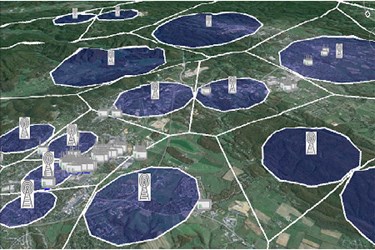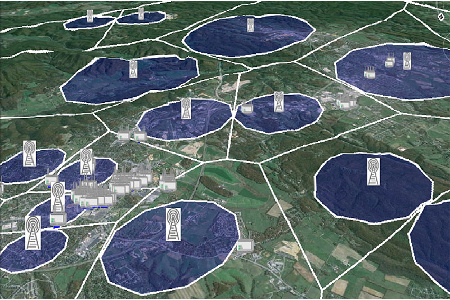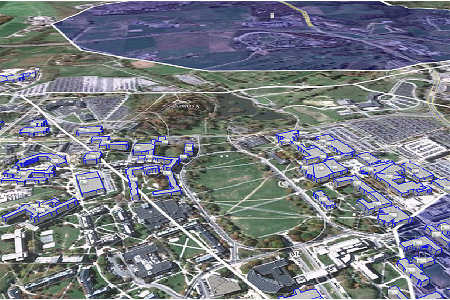A Novel Approach To Averting The Spectrum Crisis
By Jim Pomager, Executive Editor

We’re running out of mobile broadband spectrum — fast.
The migration from feature phones to smartphones, the proliferation of tablets and other mobile devices, increased penetration of wireless services, an upsurge in video consumption and social media activity, and the transition from fixed to mobile computing have all conspired to bring us to this point, teetering on the brink of a broadband catastrophe. If machine-to-machine (M2M) communications and the Internet of Things (IoT) are even half as big as anticipated, we’re headed right over the edge.
The exact amount of spectrum needed to satisfy imminent demand and avoid disaster is a matter of much speculation. The FCC has stated that the U.S. could face a spectrum shortage of up to 300 MHz by 2014. Market research firm Infonetics Research forecasts that the country will require some 1000 MHz of mobile spectrum by 2017 to meet projected usage needs. During a panel session I attended at the IEEE RFIC Symposium earlier this summer, a speaker from Qualcomm said his company expects we’ll need 1000x more wireless network capacity in the not-so-distant future, perhaps as soon as five years from now. Regardless of how big you think the problem really is, I think we can all agree that it’s definitely a problem. (And, to be fair, the U.S. isn’t the only country facing such a deficit.)
Some progress has been made in addressing the issue, and more help appears to be on the way. HSPA+ and LTE have improved transmission efficiency over limited spectrum resources, and LTE Advanced (coming soon!) promises further improvements in capacity, thanks to carrier aggregation and other advanced techniques. Network operators have been building out heterogeneous networks (HetNets), layering small-cell technologies underneath macrocell infrastructure to extend their coverage. The FCC is scrambling to free up hundreds of megahertz of government-owned spectrum for wireless broadband use, thanks in part to continued prodding from the White House.
Still, concern remains about whether all these approaches combined will free up enough bandwidth to offset rising demand in time. If not, what then?
A compelling solution to the problem could come from, of all places, Idaho. Dr. Juan Deaton, a wireless systems researcher at the U.S. Department of Energy’s (DOE’s) Idaho National Laboratory (INL), has developed a spectrum optimization method and framework that could help network operators more accurately predict demand, opportunistically reuse their own spectrum, take advantage of vacant spectrum, identify optimal locations for new infrastructure, and even cooperate with other operators to share unused spectrum as needed.
Deaton’s patent-pending approach is based on mathematical techniques using optimization theory. It synthesizes FCC-allocated spectrum bandwidths, existing transmitter locations, population data, and historic demand to generate a graphical network model that plots optimal spectrum usage in a given region, essentially recommending how best to assign spectrum channels to meet demand. The method could help network operators identify opportunities to better utilize their own spectrum holdings — say, by reallocating LTE carriers to unused GSM frequencies — or capitalize on available unlicensed spectrum, like TV white spaces. By incorporating other geographic information system (GIS) data like building footprints, the system can also help pinpoint ideal locations for new femtocells in underserved areas.

These capabilities are all well and good, but where Deaton’s method could make some real headway in solving the broadband crisis is through spectrum sharing, enabling carriers to dip into a communal pool of available spectrum when demand exceeds their licensed capacity. Whether such a pool is established in TV white spaces, government-owned spectrum, or IMS band-like unlicensed spectrum, Deaton’s system would provide regulators or third-party administrators with a tool to balance the spectral needs of multiple operators for maximum public utility.
“Our work solves multiple problems with sharing or pooled spectrum,” Deaton told RF Globalnet. “First, unlike with Wi-Fi deployment, spectral resources are optimally assigned and coordinated. Second, the spectral resources are assigned for maximum public benefit, and spectrum usage is reported by the user of the spectrum [to the regulator/administrator], in order to prevent spectrum squatters that may wish to prevent new entrants from using the spectrum.”

There are indications that the FCC will implement some form of spectrum sharing in the 1755-1780 MHz, 3.5 GHz, and/or 5 GHz bands within the coming year. The President’s Council of Advisors on Science and Technology (PCAST) is pushing the shared spectrum approach, based on a projected 1000x increase in U.S. spectral capacity through sharing of federal spectrum (sufficient to meet even Qualcomm’s extreme demand estimates!).
Even the major wireless carriers have started to soften their stance on spectrum sharing: Earlier this year, AT&T, Verizon, and T-Mobile announced they had entered a memorandum of understanding with the Department of Defense to explore the viability of spectrum sharing in the 1755 to 1850 MHz band. Results from the group’s initial monitoring and modeling simulation and analysis were made publically available last month through the National Telecommunications and Information Administration’s (NTIA’s) Commerce Spectrum Management Advisory Committee (CSMAC), a group of private-sector spectrum experts working with government to determine how to transition spectrum in the 1695 to 1710 MHz and 1755 to 1850 MHz bands from federal to commercial broadband use.
Now all that’s needed is for someone to show that spectrum sharing can really work, on actual equipment in real-word environments. Deaton, for one, believes his network optimization method is up to the challenge, and that INL offers the perfect place to test and demonstrate it — a wireless testbed situated on almost 900 square miles of government land. The site currently operates commercial-grade CDMA, GSM, UMTS, and WiMAX systems, and was recently designated by the DOE as the wireless national user facility for the development of next-generation wireless technologies.
Deaton is looking for a dance partner, preferably an infrastructure vendor willing to implement his technique in a full-scale network at the INL test range. The partnership would not be without its risks, and rewards. “The PCAST estimated a similar effort would cost $80 million over three years, and uncertainty with future regulation is an obstacle,” Deaton explained. “But the global economic benefit of having a fully connected wireless life is predicted to be $4.5 trillion in 2020 alone, which would seem to be well worth the investment.”
What are your thoughts about this approach, and about spectrum sharing in general? Will it do enough to avert the spectrum crisis? Will other measures (e.g. more aggressive Wi-Fi offload) be necessary — or even more effective? Share your opinions in the Comments section below.
For further technical details on Deaton’s spectrum optimization framework, see:
- The Effects of a Dynamic Spectrum Access Overlay in LTE-Advanced Networks (INL publication – PDF)
- Supporting Dynamic Spectrum Access in Heterogeneous LTE+ Networks (INL publication – PDF)
- Systems, Apparatuses, and Methods to Support Dynamic Spectrum Access in Wireless Networks (U.S. patent application)
- Accelerating Spectrum Sharing Technologies (IEEE Communications Magazine article)
Dr. Juan Deaton can be reached at juan.deaton@inl.gov.
